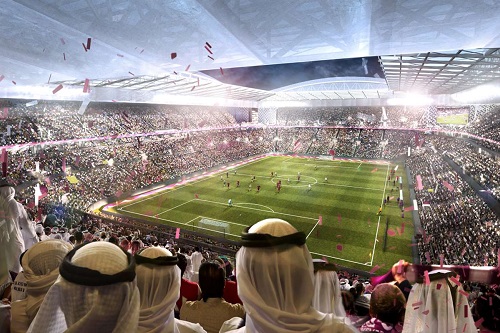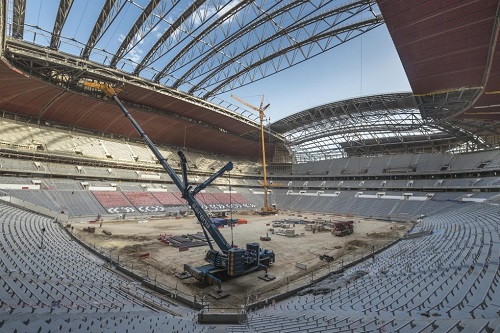Qatar World Cup organisers give venue progress update four years from event

With the 2022 FIFA World Cup just four years away, Qatari organisers for the event have given an update on progress at the stadium sites.
Coinciding with FIFA President Gianni Infantino advocating for the event to be expanded from 32 to 48 teams, and for matches to also be played in other Arabain Gulf nations, Qatar's Supreme Organising Committee for the tournament continue to plan for eight stadia for the event.
With one stadium fully redeveloped and seven others under various stages of construction, all the infrastructure projects are set to be completed well before the tournament begins on 21st November 2022.
At Al Wakrah Stadium (capacity: 40,000) work advances at a rapid pace. The stadium structure is now completed and work is progressing on internal finishes, the roof and façade works.
The energy centre that will serve the stadium has been built, while the precinct infrastructure and hard landscaping are advancing.
Inspired by the late British-Iraqi architect Dame Zaha Hadid, the futuristic Al Wakrah Stadium will host matches up to the quarter-finals stage during Qatar 2022. The design is inspired by the sails of traditional dhow boats – in tribute to Al Wakrah’s seafaring past.
An innovative cooling system and retractable roof mean the stadium will be used all year round.
At Al Bayt Stadium - Al Khor City (capacity: 60,000) the stadium structure has been completed, along with the installation of the retractable roof. Works within the precinct infrastructure and landscaping are progressing at the venue.

The arena, designed to represent Arab hospitality, will host matches through to the semi-finals stage in 2022 and will be covered by a structure resembling a traditional Arab tent known as ‘bayt al sha’ar’, complete with a state-of-the-art retractable roof.
At Al Rayyan Stadium (capacity: 40,000) the installation of the compression and tensile roof steel structure modules has been completed, while façade installation has commenced, along with testing of the energy centre.
Designed by Ramboll, Al Rayyan Stadium will showcase the very best of Qatari culture in 2022 as it hosts matches up to the quarter-finals stage of Qatar 2022.
The outer façade will be made up of intricate patterns representing Qatar, from its history of trade to its varied wildlife. Al Rayyan’s desert landscapes will be reflected on the façade – and in the dune-shaped hospitality areas and merchandise stalls dotted around the stadium complex.
At Education City Stadium (capacity: 40,000) designed by FIA Fenwick Iribarren Architects, progress continues to be made at the ‘Diamond in the Desert’. More than 220,000 metre³ of concrete has been casted, fabrication of the shimmering façade is almost complete and the roof structural steel works are progressing rapidly.
More than 80% of Al Thumama Stadium’s (capacity: 40,000) concrete frame has been completed, while work on the stadium’s upper tier steel structure is progressing well.
Precinct works are also in progress, including installation of water tanks, training pitches and other utilities and services.
Ras Abu Aboud Stadium (capacity: 40,000) will be the first fully demountable and re-usable tournament venue in FIFA World Cup history. Designed by Fenwick Iribarren Architects, this 40,000-capacity stadium will be built using shipping containers and other modular materials. Overlooking the stunning Doha Corniche and West Bay skyline, the stadium will host matches up to the quarter-finals stage in 2022.
The fabrication of containers for Ras Abu Aboud Stadium commenced in August this year, with the first batch expected in Doha in February 2019. The venue will be built using 998 modular containers. The prefabricated modular structure allows for the use of fewer materials and reduces waste and emissions.
At Lusail Stadium (capacity: 80,000), the 24th – and final – main structural column to support the stadium façade has been installed. Meanwhile, concrete superstructure works are progressing in all zones, reaching the fifth and sixth floors in the east and west sides respectively, where the structure will reach 80 metres at its highest point.
On 19th May 2017 Khalifa International Stadium became the first 2022 FIFA World Cup stadium to open when it hosted the Emir Cup final in front of more than 40,000 fans. Located in Aspire Zone, the historic venue has previously hosted the Asian Games, the Gulf Cup and the AFC Asian Cup.
Next year it will host the 2019 IAAF World Athletics Championships.
Images: Artist's impression of the completed Al Rayyan Stadium (top) and the Al Bayt Stadium during its current construction (below).
Related Articles
5th October 2018 - Qatar reveals upgraded Khalifa International Stadium
18th September 2018 - Qatar to donate World Cup stadium seats to nations in need of sporting infrastructure
29th July 2018 - Newspaper report alleges Qatar sabotaged 2022 FIFA World Cup rivals with smear campaign
12th July 2018 - FIFA announce that World Cup Stadia meet green standards
9th June 2018 - Qatar’s Al Thumama Stadium wins prestigious international architectural accolade
1st April 2018 - Qatar World Cup migrant workers to receive compensation
21st January 2018 - Revelations from former FFA Executive set to reopen 2018 and 2022 FIFA World Cup hosting controversy
28th November 2017 - ‘Reusable’ stadium plan revealed for waterside FIFA 2022 World Cup venue
22nd November 2017 - Qatar’s World Cup back in the spotlight at US FIFA trial
29th November 2016 - Qatar World Cup stadium reaches construction milestone
10th November 2016 - Building towards green stadiums for the FIFA 2022 Qatar World Cup
20th November 2014 - Doha to host 2019 IAAF World Championships






